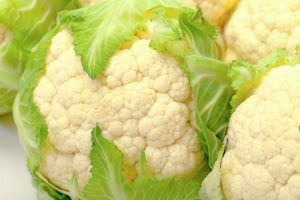Cauliflower: The versatile wonder vegetable

When you’re following a strict diet to calm inflammation, repair a leaky gut, or manage an autoimmune disease, the lack of variety can be frustrating. But you’d be surprised how deftly the humble cauliflower can jazz up your meals. Cauliflower’s first impression is not good. It’s pale, bland, and smelly when steamed. But cauliflower’s gift is in shape-shifting ability to mimic a variety of dishes by taking on the flavor of whatever it’s cooked with. Another plus? Cauliflower keeps well, patiently waiting for up to a few weeks in the refrigerator drawer for your attention, and prepping it is easy.
Mark Twain said “cauliflower is nothing but cabbage with a college education.” Indeed it is related to cabbage and a member of the disease-fighting brassicas, which also include broccoli, kale, and Brussels sprouts. Cauliflower is low in calories, high in fiber, and rich in vitamins and minerals, including vitamin C, potassium, folic acid, and a health protective compound called isothiocyanate.
Although rich in nutritious cancer-preventive phytochemicals, cauliflower also contains goitrogens, compounds that can suppress thyroid function. However, cooking neutralizes much of this property and cauliflower and brassicas are fine for many people with low thyroid activity when eaten in appropriate amounts (for example, not juiced and consumed in large quantities.) The more sensitive thyroid patients may want to monitor the effects of brassicas on their thyroid health. But for the average person the health benefits of cauliflower and other brassicas far outweigh any potential effects of goitrogens, the risks of which are not well documented in the first place.
Cauliflower’s beauty is in its versatility, especially if you are on a restricted diet. Once you discover how to work with it, you may find it becomes a regular item in your shopping cart. Below are some of the ways you can enjoy cauliflower.
Mock mashed potatoes. When seasoned well, mashed cauliflower can be a delicious and attractive substitute for mashed potatoes without skewering your blood sugar. Steam or simmer in broth before mashing, and add garlic, salt, pepper, and your choice of healthy fat (ghee, olive oil, coconut oil, butter, or even duck fat).
Cauliflower rice. The secret to cauliflower rice is to pulse cauliflower florets in the food processor until it’s the size of rice grains. Sauté it in a pan with onions and a healthy fat and season.
Cauliflower pizza crust. Cauliflower pizza crust starts with using the food processor to make cauliflower rice, cooking (most recipes call for the microwave for this step), wringing it dry in a kitchen towel, and then mixing with egg and seasoning before flattening onto a pizza stone and baking. Then top with your favorite ingredients and bake again.
Roasted cauliflower, or cauliflower “popcorn.” It doesn’t sound that interesting, but roasted cauliflower can be a surprising crowd pleaser, especially if seasoned creatively. Cut cauliflower florets into uniform pieces, toss with your favorite oil and seasoning, and flip occasionally while roasting until evenly browned.
Cauliflower puree. Pureeing cauliflower in soups is a wonderful way to create a thick base without blood sugar-spiking flours. Add it to your favorite broth with sautéed onion or shallots and garlic, puree, season, and throw in some chopped vegetables for color.
Read more http://michaelruscio.blogspot.com/2013/09/cauliflower-versatile-wonder-vegetable.html
Discussion
I care about answering your questions and sharing my knowledge with you. Leave a comment or connect with me on social media asking any health question you may have and I just might incorporate it into our next listener questions podcast episode just for you!